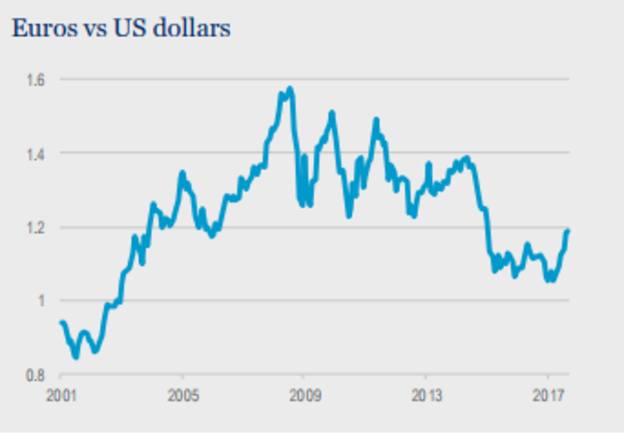
Article 2 / 4
Guide to investing in EuropeWhere are the opportunities in European equities?

European equities are finding a place in investors’ portfolios once more.
“Sentiment on the investment case for European equities has shifted. Earlier in the year it was a consensus underweight among investors and is now a consensus overweight”, observes Guy Foster, head of research at Brewin Dolphin.
“This has not only been driven by a dramatic improvement in the political environment but a global upturn in economic activity.”
A lack of profits growth among European companies has been one of the reasons for their underperformance.
Edward Rumble, portfolio manager of the RWC Pensato European Equity fund, points out: “The relative earnings performance of European companies has significantly lagged that of the US.
"There are a multitude of reasons for this, but two significant contributors have been that while Europe grappled with austerity and deflation, the US policy response to stimulating economic growth after the crisis was more constructive and expansionary.
“In addition, the weighting of high growth businesses such as the technology giants (Google, Apple, Facebook, Amazon) is a bigger part of the US market, while European indices have a higher weighting in banks and commodities stocks where growth has been a problem recently.”
He also suggests the risk premium ascribed by investors to European equities has been high relative to other developed markets, due to a legacy of the uncertainties over the euro, sovereign debt, systemic risks in the banking system and more unstable socio-political conditions.
Finding financials
But the region’s financial sector does appear to be improving, having underperformed the wider market since the financial crisis (see chart).
Figure 1: Financials versus Eurostoxx

Source: Datastream, Rathbones
Financials is one of the cyclical sectors where Dylan Ball, executive vice president, portfolio manager at the Templeton Global Equity Group, sees opportunities.
He explains: “The eurozone banking industry has continued to progress with restructuring and recapitalisation efforts, and it remains an attractive option. Earnings revisions at European banks have returned to a positive trajectory, regulatory capital has been largely rebuilt, and the bulk of post-crisis re-regulation efforts is now complete.
“Also encouraging are the swift resolutions of recent issues at regional ‘problem banks’, which indicate a newfound sense of urgency and resolve among regulators determined to ensure systemic stability.”
Liontrust’s Olly Russ, a European income fund manager, is also optimistic about the prospects for European financials.
He reasons that while investors remain wary of financials there have been very good returns to be had from the insurance sector in particular.
“Looking forward, some banks (though not all) have entirely transformed their capital positions, with the likes of Swedbank, for example, offering even now yields of circa 6.4 per cent. If one were to perceive banks as essentially warrants on economic growth, parts of the sector look interesting.
“Elsewhere, there are fund management groups and specialist financials which also look quite attractive as Europe recovers, markets and confidence rise, and bad debts subside,” he adds.
Jeff Taylor, head of European equities at Invesco Perpetual, has identified interesting valuation opportunities in out-of-favour sectors at the value end of the spectrum, including energy, telecoms and financials.
“There are also sectors which we are currently avoiding – typically many of those which have attained ‘bond proxy’ status in recent years and to our minds have become very expensive as a result,” he notes.
“Consumer staples such as food and beverage stocks are cases in point. These are often companies with extremely strong and respectable track records – it is easy to understand their market image – but it’s important to remember that a good company does not necessarily make a good investment.”
Far and wide
Rather like emerging markets, Europe is not a homogeneous region.
Instead, it is made up of many countries at different stages of the economic cycle, and some with more opportunities for stockpickers than others.
For example, Spain’s economic recovery has been particularly strong but managers caution this does not necessarily translate into investable companies.
Mr Rutherford argues: “Apart from the recent issues with Catalonia in Spain, because Spain has been one of the fastest-growing counties in Europe, it doesn’t mean it’s a haven for stockpicking, because it’s not.
“When you break down their GDP growth you’ll see it’s predominantly tourist driven, which doesn’t affect the real economy really. Ok, it might affect some of the consumer areas in Spain but it doesn’t increase industrial output in Spain.”
Ritu Vohora, equity investment director at M&G Investments, admits: “The Spanish recovery has been noteworthy, with GDP growth back to pre-crises levels, an improvement in the labour market and continued reform of the banking system – but recent political uncertainty has tempered sentiment.”
Instead, Ms Vohora believes Eastern Europe looks particularly interesting and could provide some upside potential.
“These economies provide higher potential returns, with much stronger loan growth than peers, which means that the stock trades on a more attractive valuation, offering a healthy dividend yield and decent growth.
“A longer term theme that could also benefit peripheral Europe is China’s One Belt and Road initiative, which aims to boost economic development, investment, and cultural exchanges throughout Eurasia by funding port, rail, and road construction along routes linking China and Europe,” she says.
David Stubbs, head of client investment strategy for EMEA at JP Morgan Private Bank, is rather more keen on France, where the recently-elected president Emmanuel Macron is helping French firms.
He explains: “Compared with other European countries, it has a higher weighting to domestic companies and it is in a prime position to benefit from the uptick in economic activity.
“We are seeing President Macron making progress, and his reforms have the potential to boost the earnings growth of French companies.”
Currency moves
The fortunes of Europe’s companies are closely tied to the currency, which may be a headwind in 2018.
James Rutherford, co-head of investments for European equities at Hermes Investment Management, acknowledges it has been something of a “perfect storm” for European companies recently.
He explains: “I don’t know what the earnings growth forecasts are for this year, but they were north of 10 per cent and they’ll probably stay around 10 per cent and that’s the first time in 10 years that the earnings expectations are being met.
"It’s very broad based, so most parts of the market are actually growing, which is very unusual.
“The one caveat I would put on that is obviously global growth can be upset by any sort of factor, be it terrorism, currency moves, natural disasters. So you have to bear in mind that there are risks still out there to this particular picture.”
He highlights one of those risks in particular – the euro.
Figure 2: Euros versus US dollars

Source: Datastream, Rathbones
“I think perhaps where people are being quite sanguine about is the effect of the euro move against the dollar and having been a benefit coming into this year, a tailwind to earnings, it does provide a headwind now and we’re beginning to see that in corporate results,” he cautions.
“So your headline earnings are being somewhat cut going into next year and that remains a risk.”
eleanor.duncan@ft.com



